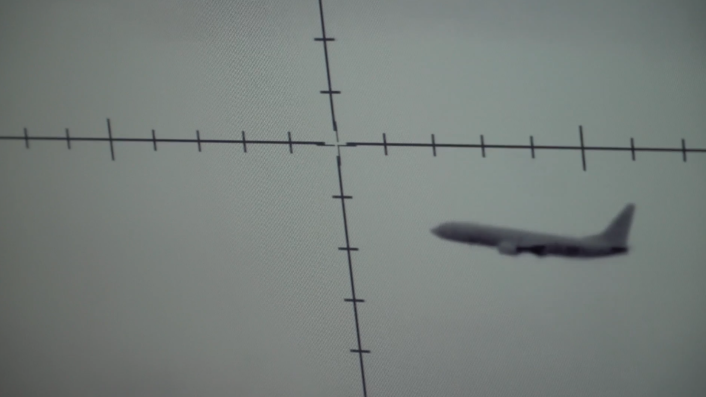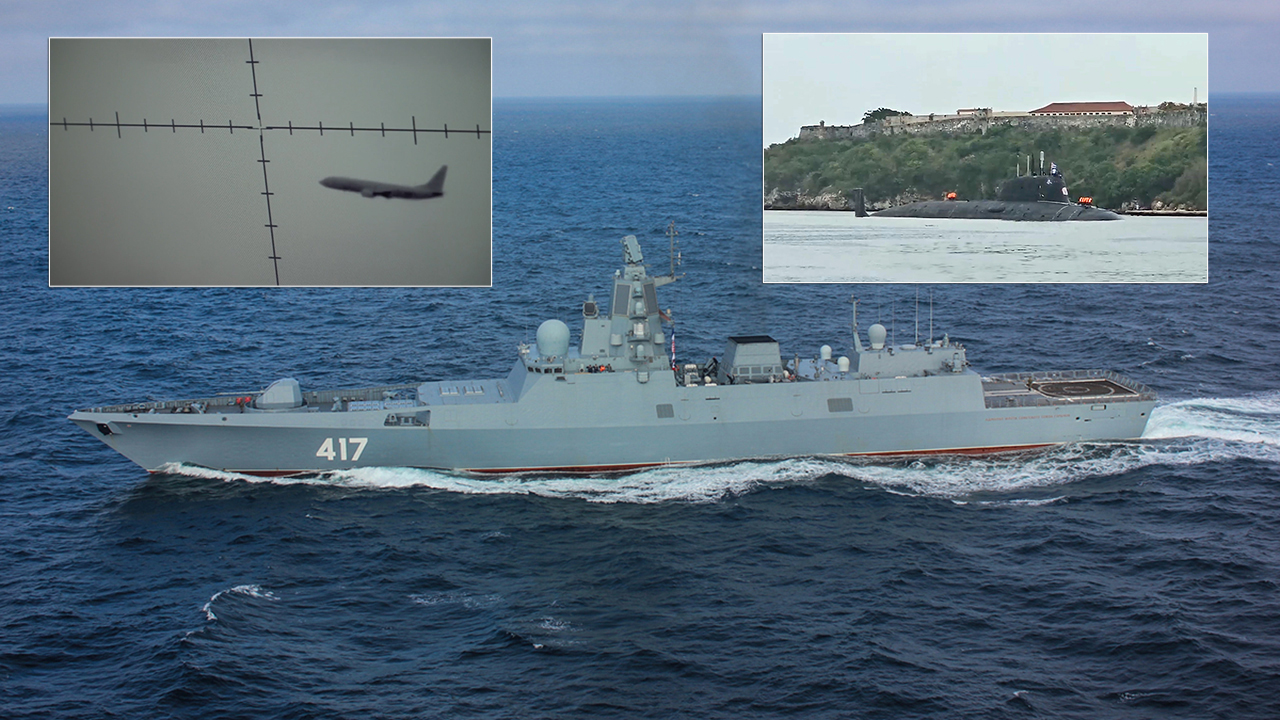A Russian naval deployment to Havana, Cuba comprising a frigate, nuclear submarine and support vessels arrived at its destination on June 12, 2024, after attracting the attention of NATO military forces and Western media.
As previously reported on The Aviationist, the Russian Navy has dispatched a long range deployment from its Northern Fleet across the Atlantic Ocean to Havana, Cuba. This deployment consists of the modern guided missile frigate Admiral Gorshkov, Yasen class nuclear-powered cruise missile submarine Kazan, refueling vessel Academic Pashin, and support tug Nikolai Chiker. The latter support tug is a common feature of overseas Russian Navy deployments, which lack the wide array of friendly ports available to many Western naval forces in case of emergency mechanical issues.
The Admiral Gorshkov is the lead ship of the Project 22350 or Admiral Gorshkov class of guided missile frigates which have been in production since 2006. It is a modern frigate design, incorporating features to reduce the ship’s radar signature as well as a significant weapons capacity. Sixteen of its vertical launch system (VLS) cells are capable of firing Kalibr cruise missiles, Onits anti-ship missiles or the new Zircon hypersonic missile. Thirty two more VLS cells are included for anti-aircraft missiles, which complement the ship’s two Palash close-in weapons system (CIWS) mounts. The class suffered from heavy delays during development, resulting in Admiral Gorshkov as the lead vessel only entering operational service in 2018. All three frigates of the class commissioned so far have been assigned to the Northern Fleet.
Joining the Admiral Gorshkov in Havana, and the last of the four vessels to arrive in port, the Kazan, pennant number K-561, is one of the Russian Navy’s newest submarines. As a nuclear-powered cruise missile submarine (SSGN) of the Yasen class the boat is designed to carry a heavy payload of cruise missiles, launched from eight VLS silos. Missile types employed include the same Kalibr and Oniks missiles used by the Admiral Gorshkov frigate, with Zircon hypersonic missiles a likely future option. The Kazan was the first boat produced of the Yasen-M subclass, which are slightly smaller than the one-of-a-kind first of class Severodvinsk which was laid down a full sixteen years prior to Kazan. This is likely the result of newer technology allowing a smaller crew size, as well as a newer generation of reactor.
The nuclear power submarine Kazan arriving in Havana. Cubans telling me it’s the first time they have seen a sub come into the city like this. pic.twitter.com/XRBHtSjHAJ
— Patrick Oppmann CNN (@CNN_Oppmann) June 12, 2024
NATO’s Watchful Eye
Deploying such new vessels across the Atlantic and close to the Eastern coast of the United States provides NATO forces with a significant opportunity to monitor and gather intelligence on current Russian naval capabilities. Of particular note will be acoustic signatures, particularly for the Kazan. It is possible that the comparably noisy attached support tug and tanker have been employed in a double-role by the Russian Navy during the journey in an attempt to mask the more sensitive signatures of the combat vessels.
Western media covered the story of the deployment as it neared the US East Coast and after the port visit to Havana was confirmed by the Cuban Ministry of Foreign Affairs. On their final approach to Cuba, it is reported that the Russian vessels came within thirty miles of the Florida coast. It is apparent however that NATO forces had been actively tracking the deployment long before, with a video posted on May 23 by a Russian Ministry of Defence account on Russian social media service VK showing the Admiral Gorshkov’s crew tracking a P-8A Poseidon maritime patrol aircraft operating near their location.

Upon reaching the West Atlantic the fleet was tracked by both NATO airborne and surface assets. Boeing P-8A Poseidon aircraft based at Naval Air Station Jacksonville in Northern Florida were augmented by a Lockheed CP-140 Aurora operated by the Royal Canadian Air Force and forward deployed to the base. The CP-140 is based on the P-3 Orion platform that was formerly the mainstay of the U.S. Navy maritime patrol fleet, but it instead adapted the electronics suite from the now retired carrier-based Lockheed S-3 Viking. Canada has ordered the P-8 Poseidon to replace its aging CP-140 fleet, but in the meantime has kept the Aurora up to date with ongoing upgrades.
Both aircraft types are capable maritime patrol platforms, able to operate long duration sorties performing surface surveillance with radar and electro-optical/infrared imaging systems. Underwater monitoring can be achieved by deploying sonobuoys from launching tubes at the rear of the aircraft.
The two air arms rotated overwatch responsibilities as the aircraft followed the Russian ships as they edged closer to the Eastern coast. They flew with Mode S transponders active, and were subsequently tracked by users utilizing online flight tracking services such as ADS-B Exchange.
P-8A Poseidon #AE686F says “Seeee ya!” and departs the area after handing off the surveillance to Royal Canadian Air Force CP-140 Aurora #C2B1ED as 140108. pic.twitter.com/SrVPUNIn8f
— TheIntelFrog (@TheIntelFrog) June 10, 2024
Passengers aboard the cruise ship Celebrity Reflection came within visual distance of the Russian fleet on June 11, capturing images of both the Russian vessels and the NATO vessels shadowing them. Royal Canadian Navy frigate HMCS Ville de Quebec (FFH 332) and a La Fayette class frigate of the French Navy (likely Guépratte, which departed Colombia on June 10) were visually identified from the cruise ship, while U.S. Navy Arleigh Burke class guided missile destroyers USS Donald Cook (DDG 75), USS Truxtun (DDG 103) and US Coast Guard Legend class cutter USCGC Stone (WMSL-758) could be identified via automatic identification system (AIS) tracking data.
HCMS Ville de Quebec from the 6th deck of the Celebrity Reflection today. Could see the 332 designation through binoculars so it’s definitely her. pic.twitter.com/4jGbYPfQtI
— David Evert (@davidcevert) June 11, 2024
While both the Admiral Gorshkov and the submarine Kazan are capable of carrying nuclear warhead equipped weapons, United States government officials have stressed that they do not believe either vessel is nuclear armed on this deployment. This was corroborated by a statement from the Cuban government. United States Department of Defense spokesperson Major Charlie Dietz noted prior to the fleet’s arrival that “these deployments are part of Russia’s routine naval operations and pose no direct threat to the United States”. He also speculated that further port calls in nearby nations friendly to Russia, such as Venezuela, may be likely following Havana.
Deputy Pentagon Press Secretary Sabrina Singh confirmed on June 12 that U.S. Navy, U.S. Coast Guard and Canadian naval forces had been conducting routine operations in the Atlantic, and that the situation would continue to be monitored.













